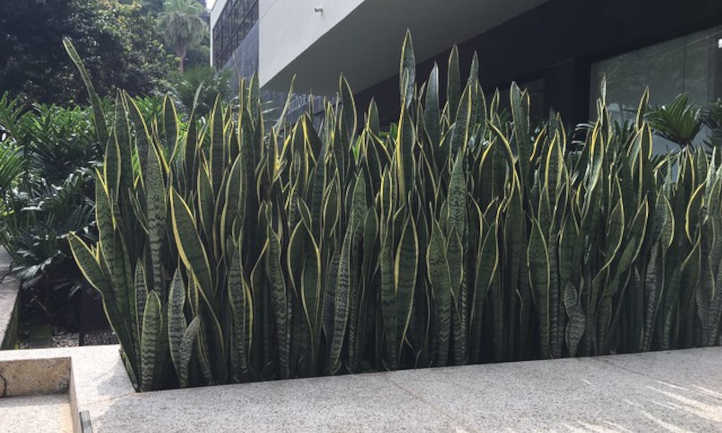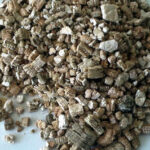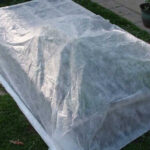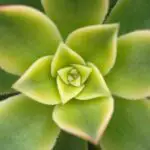The snake plant is one of many well-known houseplants, due to its ability to purify air quality and adorn domestic spaces with its lovely dark green leaves. It’s a succulent plant that is easy to propagate and care for. If you don’t already have an indoor snake plant, you can easily take leaf cuttings from a healthy one, and make a new snake plant. There are variations on the basic snake plant that can add a bit of flair to any area of your home with bright indirect light. And because it’s a slow-growing plant, there isn’t much maintenance that goes into caring for it.
While this article is specific to the snake plant known as Dracaena trifasciata or Sansevieria trifasciata, if space is limited in your home, you might consider a Sansevieria ballyi, known as dwarf snake plant, or the fleshy, cylindrical snake plant Sansevieria cylindrica called African Spear. Perhaps the interesting and thick white vertical stripes of Sansevieria zeylanica (bowstring hemp) fit the design of your home, or you’re interested in Sansevieria masoniana, also known as whale’s fin. What about Sansevieria desertii, also known as rhino grass?
Whichever type you choose, you’ll have no problem growing them. So, let’s discuss this easy-going plant and how to care for it!
Subscribe to the Epic Gardening Podcast on iTunes or Spotify
Snake Plant Overview
| Common Name | Snake plant, mother-in-law’s tongue, viper’s bowstring hemp |
| Scientific Name | Sansevieria trifasciata or Dracaena trifasciata |
| Family | Asparagaceae |
| Height & Spread | Up to 40 inches tall, or 3.5 feet tall |
| Light | Direct sunlight, filter harsh sunlight |
| Soil | Free draining soil |
| Water | Every 2 to 8 weeks |
| Pests & Diseases | Root rot, rust, mealybugs, spider mites |
All About Snake Plants
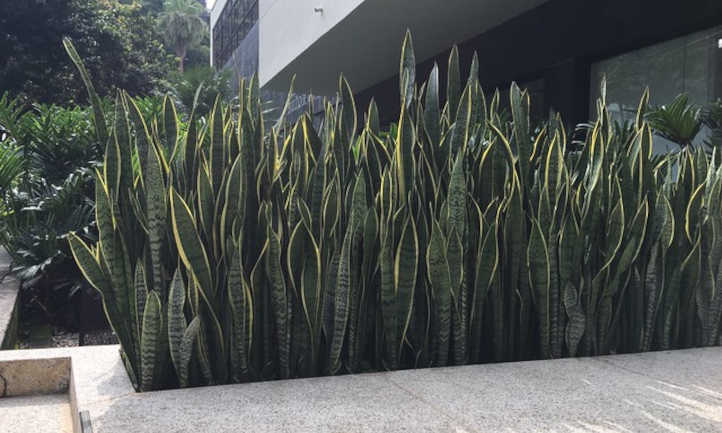
The snake plant was botanically classified as Sansevieria trifasciata until 2017 when it was reclassified as Dracaena trifasciata. It is commonly known as mother in laws tongue, St. George’s sword, and viper’s bowstring hemp. Like many succulents, the snake plant comes from tropical West Africa. Snake plants are upright broadleaved herbaceous perennials that grow in a rosette formation. As clumps of the plant’s sword-like leaves grow in thick stands which reach about 3 feet tall, they spread out via rhizomes and seeds that develop from their cream-colored to light green flower stalks. The snake plant usually only blooms in its natural environment. But that doesn’t mean snake plant propagation is off-limits. They can easily be propped from a healthy leaf cutting – therefore, it’s best to grow this sometimes invasive plant in pots.
Snake plants have different appearances depending on the variety in question. The white snake plant is lovely, and so are snake plants with yellow variegated edges on their leaves. One of the most popular snake plants on the market today is Bantel’s sensation, which has narrow leaves and white vertical stripes. Some varieties even have succulent red-tinted leaves that accent any space they inhabit.
Many people are aware of snake plants due to their ability to purify the air around them. Peer-reviewed studies conducted in India in 2020 revealed that snake plants are more effective than air purifiers in removing toxins in the air – specifically benzene and formaldehyde. So if you see Bantel’s sensation in a store somewhere, bring it home for clean, fresh air. We should also note that snake plants are toxic to pets, so keep them out of reach of your pets and children. If they’re consumed they can cause severe reactions that include vomiting and diarrhea.
Snake Plant Care
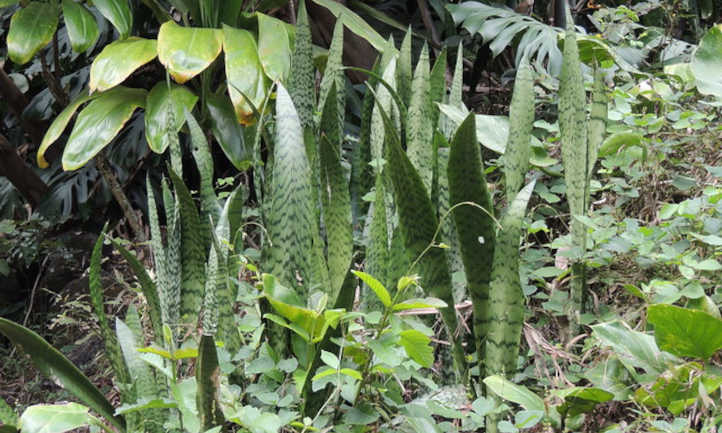
Let’s talk about the basic snake plant needs – variegated snake plant care is included. Once you have these in line, you’ll have no problem growing Sansevieria trifasciata, one of those “set it and forget it” houseplants. It doesn’t need much care, water, or light, but you still have to give it a LITTLE bit of love if you want it to thrive.
Sun and Temperature
Give your snake plant bright, indirect light, or filtered light. While it can survive in low-light areas, it will grow slower and have less color. Sansevieria trifasciata will tolerate low light but does best with brighter light. A sunny spot will be too much for it. Choose a spot in indirect sunlight about 3 to 6 feet away from a window that gets bright light. Snake plants thrive in temperate, warm, frost-free conditions. They can be grown outdoors in pots in zones 9 through 11. Outside of that, zones with freezing temperatures are too cold for snake plants. Even a light frost will kill a Sansevieria, cylindrical or otherwise. In the zones near to its hardiness range, snake plants should be brought indoors during fall and winter.
Water and Humidity
Because snake plants have succulent leaves, they don’t need too much water. Keep the mix slightly moist and never over-water. Soggy soil will make snake plants become mushy and increase the likelihood for diseases like root rot to take hold. Water your variegated snake plant or your Sansevieria cylindrica lightly in the morning every two to 8 weeks, depending on the season. In summer, water every 2 weeks, and in winter, water every 8 weeks. You’re not so much at risk of damaging snake plants from under-watering as you would overwatering. So let the mix dry out completely between irrigation. The optimal humidity for snake plants is 30% to 50%, which is right where most homes lie.
Snake Plant Soil
Plant experts say the best type of soil for snake plants is an African violet mixture with a bit of sand added for additional drainage. If you’d like to mix your own soil, combine 1 part garden soil with 1 part peat and 2 parts perlite or builder’s sand. Your base could also consist of a well-draining potting mix in a pot that has a sizable drainage hole. This slow-grower can’t thrive in low-quality soil or mix, so be sure to use high-quality ingredients. It does well in a pH range of 4.5 to 8.5, with 5.5 to 7.5 being optimal. If you’re not sure where to purchase each element for a good soil mix, try a specially formulated snake plant soil.
Fertilizing Snake Plant
To give your snake plant a good foundation, use an organic liquid fertilizer at the soil line with an NPK of 10-10-10 once monthly during spring and summer. Find one that is free of nitrates. If you’re not sure what to get, try a specifically formulated snake plant fertilizer. Outside of the growing season, during the winter months, forego fertilizing.
Repotting Mother-In-Laws Tongue Plant
You don’t need to re-pot your snake often as it likes to be root-bound. However, if it becomes top-heavy and starts to tip over, re-pot it into a pot that is only a couple of inches larger than the current pot. Wait until the plant is just about to come out of dormancy in late winter or early spring. Then tip the pot over, retaining as much potting mix around the roots as possible. Then plant the roots and foliage into a new pot. A terra-cotta container is the best pot for snake plant. Top the rest of the pot with your soil mix, and let the new growth emerge. Repotting snake plant is a cinch!
Pruning Snake Plants
Sometimes the tips of leaves will turn brown or entire leaves will die. If this happens, all you need to do is cut the leaf right where it meets the potting mix to remove it completely. There’s no point in cutting part of a leaf as it will not grow back from the cut point. Use a sterilized cutting instrument to prevent the spread of any diseases.
Snake Plant Propagation
Snake plant propagation can be done either by cuttings in water or potting mix or by division for those grown outdoors. While I can’t recommend growing them outdoors outside their native habitat due to their invasive nature, you can divide these plants in the spring by digging them up from the earth and slowly pulling the masses of leaves apart to detangle the roots. Then cut the rest, and plant them in your preferred area. Follow the same process for houseplants, placing each mass of leaves in a new pot. Propagate snake plants by leaf cuttings and place them in water or potting mix to create new snake plants. For water-grown plants, take a 4 to 5-inch tall cutting with a sharp knife and place it in a clean jar with water. Allow it to sit out of direct sunlight until they grow 2-inch roots. Change the water every two days to prevent bacterial growth. Then plant the cutting in potting soil and give it a couple of weeks to root in. Leaf cuttings of about 2 to 3 inches should be made to propagate in potting soil. Follow the same steps you would for a water-rooted cutting, using a sharp knife to extract a healthy leaf. When new growth appears you’ll know your propagation was successful.
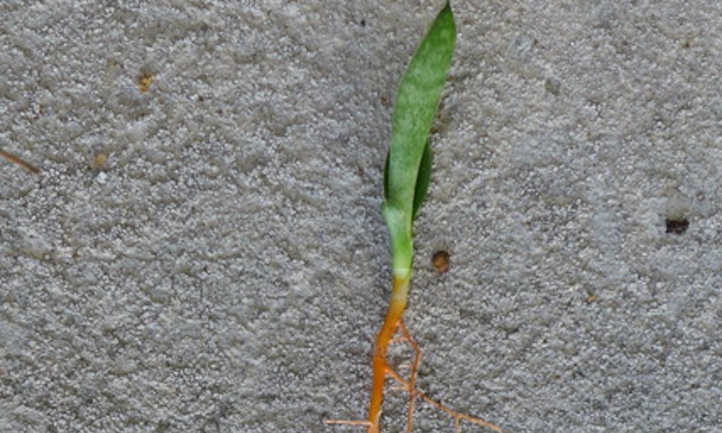
Troubleshooting Snake Plant
While you most likely won’t have to deal with pest and disease issues with snake plant, there are a couple of things to look out for. Let’s talk about those and what to do about them.
Growing Problems
The most common problem with snake plants is overwatering. Do not water more than a couple of times over the winter season, and no more than every other week in the spring and summer. Use the top inch of soil to determine whether or not it’s dry enough to add water during the growing season. You may also have issues with propagating cuttings of snake plant leaves. If you use leaves that are too long, or those that are already mushy and rotted, this will lower your chances for healthy root growth or even kill your cutting. Instead, use 2 to 3-inch leaves from your snake plant parents for soil propagation, and 4 to 5-inch leaves for water propagation.
Pests
Like many houseplants, snake plants are susceptible to mealybugs and spider mites. Both of these pests attack the dark green leaves of your spider plant similarly, sucking the sap. If you have a heavy infestation, it’s best to just start over with a new plant. But if you catch them early, you can prevent the infestation from growing. Combat spider mites by misting the plant and wiping them off. For mealybugs, wipe them off with a cotton swab of rubbing alcohol.
Diseases
The most common disease will be root rot due to over-watering. This fungal or bacterial disease is common because gardeners tend to treat snake plants like other types of garden plants that aren’t succulents, watering on the same schedule. The solution for root rot is simple: water less, and repot the plant into fresh soil to allow the roots to dry out. You may also need to cut off any mushy leaves. You may also run into fungal brown rust spots on the leaves, which is caused by allowing water to sit on the leaves during cold or cloudy periods. Remove infected leaves to prevent further sporulation. Try a copper fungicide spray applied in intervals of 7 to 10 days until the infection subsides. If this doesn’t help, you should throw the plant away and get a new one.
Frequently Asked Questions
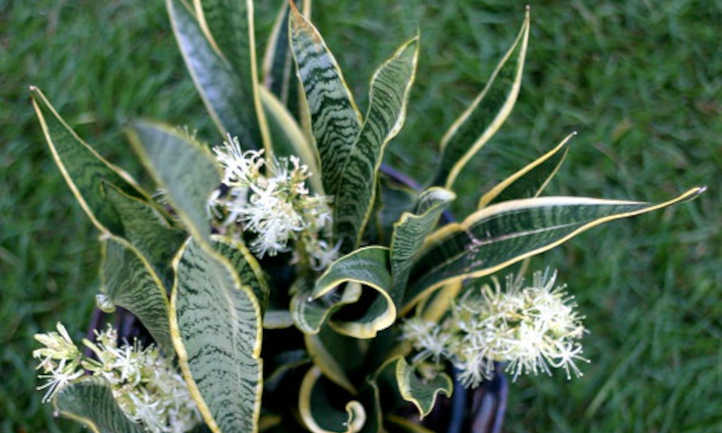
Q: Does snake plant need sunlight?
A: Yes, but indirect or filtered sun is best. Keep your plant several feet away from a sunny window.
Q: What is the benefits of snake plant?
A: It does wonders for the air quality in your house, removing the volatile compounds benzene and formaldehyde.
Q: How do you take care of an indoor snake plant?
A: Give it a good potting mix, and follow the sparse watering schedule listed above. Repot it as needed, and you’re set!
Q: Where should I place a snake plant in my house?
A: Keep it in a dapple sun, to partially shaded area out of direct light.
Q: How often should I water my snake plant?
A: Give it water every 2 weeks in spring and summer and every 8 weeks in winter.
Q: Why is snake plant unlucky?
A: According to the tenets of Feng Shui, this plant can bring negative or discordant energy into a home. But we think otherwise!
Q: Do snake plants like small pots?
A: They don’t mind being root bound, but take care to repot them regularly.
Q: How long does a snake plant live?
A: This herbaceous perennial will survive for 5 to 10 years.
Q: Do snake plants attract snakes?
A: They don’t! They’re called such because their tall leaves resemble snakes.
Q: My snake plant isn’t growing and I’ve had it for months. What is going on?
A. During the fall and winter, it’s completely natural for growth to slow down. These are the dormant months that new growth is either completely stopped or extremely slow.
Q: The leaves of my snake plant are becoming mushy but the soil is dry and I am not over watering it. What’s happening?
A. If you are positive you’re not over watering your snake plant, then there are two probable causes: your soil is holding too much water, or you have some kind of rot.
Q: The leaves of my snake plant are drooping or wrinkling, what is going on?
A. The leaves of a snake plant will droop when they’ve gotten too much water! If the leaves have a wrinkled appearance or start to bend, it’s a surefire sign that your plant isn’t getting enough water.
Q: Is the snake plant toxic?
A. All parts of the snake plant are mildly toxic to people and more toxic to pets. The saponins found in the plant can cause the human tongue and throat to swell and be numb. Animals experience worse symptoms.


